Chris Baty's Blog, page 6
October 26, 2023
Getting ready for NaNoWriMo?
 ALT
ALT ALT
ALT ALT
ALT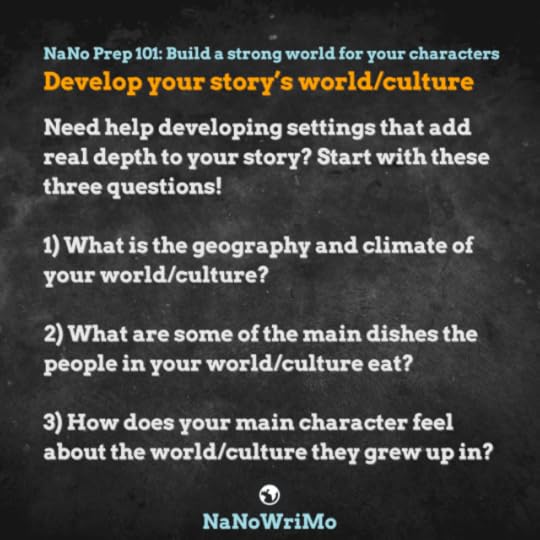 ALT
ALT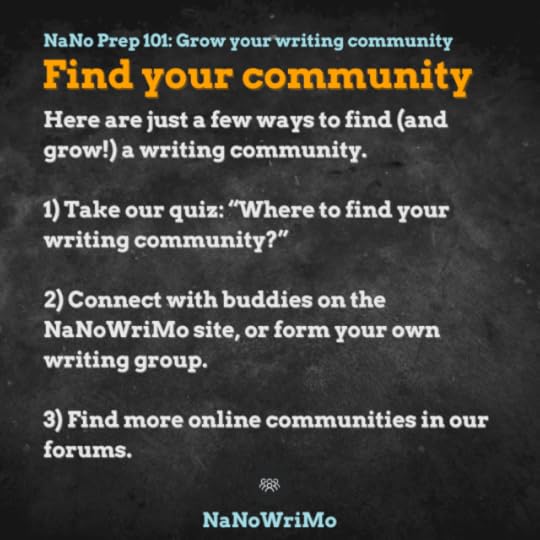 ALT
ALT ALT
ALTOver the past six weeks, we’ve shared tons of resources, activities, and advice to help you get prepared to write a novel in our “NaNo Prep 101” course.
If you literally just decided “oh hey, writing a novel sounds cool, I think I might try that,” no worries! Here’s a round-up of some of our favorite NaNo Prep activities, or you can check out our full NaNo Prep 101 page and choose your own favorites.
Doing a bunch of prep work isn’t necessary, of course—there are many NaNoWriMo writers who identify as “pantsers”, a.k.a. people who “fly by the seat of their pants”. But we hope these resources will help you find some fun and inspiration, too!
October 23, 2023
Write Smarter, Not Harder: 5 Ways to Conquer Chaotic Writing
![Black and white image of a frustrated writer at a computer with a yellow background, with text that reads "write harder [crossed out] smarter"](https://i.gr-assets.com/images/S/compressed.photo.goodreads.com/hostedimages/1698133330i/34853165._SX540_.png) ALT
ALTEvery year, we’re lucky to have great sponsors for our nonprofit events. ButterDocs, a 2023 NaNoWriMo sponsor, is an all-in-one writing app built for productivity, collaboration, and a more joyful writing experience. Today, the folks at ButterDocs share a few tips on organizing your writing to meet your goals:
NaNoWriMo is about to start, and you’re champing at the bit to get to 50,000 words. But that’s no easy feat! Because life doesn’t stop when NaNoWriMo starts.
You’re still going to have climb a mountain of chaos to reach your goal: Chaos like not being able to find your notes and outlines when you need them since they’re scattered across multiple apps, or the constant lure of internet distractions.
And of course, once NaNoWriMo ends, the writing process continues. You’ll need to get feedback, be able to actually easily take advantage of that feedback, and make revisions (especially if your ultimate goal isn’t just a rough draft, but a polished novel).
Here are five tips from ButterDocs to beat the chaos and make your writing workflow less work and more flow.
1. Know what you’re about to do.We know you want to start maximizing your word count from Day One, but you’ll thank yourself on Day Twenty if you lay the groundwork for yourself. Take some time to organize your research, develop your characters, lay out your major plot points, and consider your themes.
You don’t need to buy and learn advanced plotting software. A digital whiteboard can be as intuitive as pinning index cards to a cork board.
2. Write in the best environment for you .You’re about to spend a lot of time writing. It’s a good idea to get comfortable.
Think about what environment you write best in. Do you need the hubbub and energy of a busy coffee shop? Or the serenity of a cozy nook?
Once you find the right place, put the same effort into finding a writing app you’ll actually enjoy writing in.
3. Stay in your writing flow.Focus and dedication during NaNoWriMo is the whole ball game. Lose either, and your chances of hitting 50,000 words are harder.
Whatever your NaNoWriMo goals are, give yourself the best chances to succeed with tools that will help you get and stay focused. A timer, word counter, and goal tracker will help you with timed writing sprints and hitting daily writing goals.
4. Recover from distractions.Distractions will happen. Chaotic writing aside, the human brain wants to wander for dopamine. And life inevitably gets in the way.
What’s important is how you recover. Don’t let one distraction or missed writing day snowball into another and another. Give yourself tools that help you get back on track. A simple notification to come back to your writing can be a big help.
5. Pull others in to help you move forward.You may be participating in NaNoWriMo as an individual, but know this: you are not alone.
You have the entire NaNoWriMo community, among many other writing communities and groups you can turn to for any genre of writing.
When you feel stuck or need feedback on a draft, don’t be afraid to ask for help. Just be sure to invite people into a writing app where you have control over the collaboration.
ButterDocs Early Access + NaNoWriMo ResourcesConquer chaotic writing by using a writing app built for exactly that. With ButterDocs, you can plan, write, share, and edit your writing all in one place, without the chaos. It’s by the team that built Arc Studio, a leading screenwriting app with hundreds of thousands of users.
ButterDocs launches today in early access and we’d love to invite you to check it out for NaNoWriMo.
All NaNoWriMo participants can receive a free year of ButterDocs if you sign up by December 1st, 2023.We’re running a free online event on October 25th for everyone who signs up: “Getting (and Staying) in Your Creative Writing Zone During NaNoWriMo.” with Grant Faulkner (Executive Director of NaNoWrimo), Matt Trinetti (founder of London Writers’ Salon), and Allison Trowbridge (founder of CopperBooks). If you can’t make it, we’ll email ButterDocs users the recording afterward.Visit https://butterdocs.com/NaNoWriMo to learn more about ButterDocs, claim your free account, and enter an exclusive sweepstakes giveaway for NaNoWriMo participants!
October 18, 2023
30 Covers, 30 Days 2023: Sign-Ups Open!
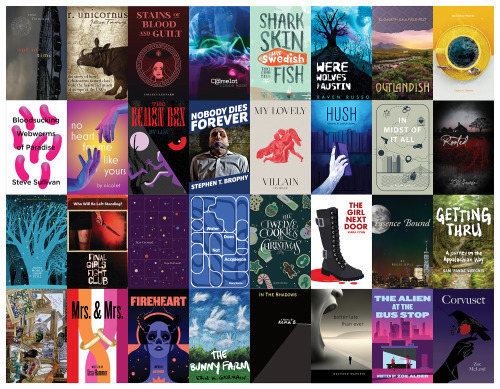
Hey, Wrimos!
It’s that time of the year again: 30 Covers 30 Day Sign-up season! This year, we’re doing things a little bit differently. We’ll still have the classic 30C30D experience in which you get the chance to have a cover designed by a professional graphic designer. Alongside the professional designs though, we’re adding the chance to highlight designers in our community!
So, let’s get all that information rolling!
What’s 30 Covers, 30 Days?Every November, a handful of Wrimos will be selected to receive a unique cover for their NaNoWriMo Novel! These covers are designed in 96 hours by a group of talented and diverse professional graphic designers, recruited by our amazing 30C30D coordinator, Debbie Millman.
This year, 22 lucky Wrimos will be chosen!
When November hits, you’ll get to see a new cover daily on the forums, as well as the NaNo blog and Instagram! Past covers can be seen here.
How do I get a cover from a professional designer?All you have to do is fill out this form and nominate your own novel!
Here’s some things to keep in mind:
If you make any mistakes, feel free to edit your previous submission! Make sure you send a copy of the form to yourself at the very end. If you want to remove your submission altogether, please go back in the form and check off the box that asks for removal at the very end.You do not have to share your real name on the nomination form. Preferred names, pen names, or any kind of name you’d like to use are not only welcomed, but celebrated!Wait, what’s this about a community feature?Notice how we only have 22 covers done by professional designers this year? Well, who’s going to fill out the other 8 days?
That’s when the community comes in!
We’ve noticed a lot of you are talented designers in your own right and we wanted a chance to showcase those designs. This cover can be one you’ve created in your own free time or a cover someone created for you in the Artisan Forums.
Sweet! How do I submit a nomination for the community feature?All you have to do is fill out this form and submit an image of the cover design!
Here’s something super important to keep in mind:
Please make sure both the artist and writer are aware their cover art/novel is being submitted! We know that in the NaNo forums, getting cover art is usually a gift from another Wrimo. As a result, please make sure you have permission from the artist or writer before submitting! Maybe send them a private message to make sure. (Of course, this doesn’t apply to you if you designed your own cover.)Can I submit to both forms?Sure! But you won’t be picked for both.
Can I use AI Images in my cover design?In general, the goal of participating in NaNoWriMo is to motivate yourself to write and give yourself space to develop your creativity. We want to carry that idea onto any visual art presented here as well! It’s less about a sophisticated end project and more of the fun journey you took, isn’t it?
Furthermore, AI image generators can run into some very specific legal and ethical issues. Here’s a few articles if you want to learn more about this topic!
The great AI art debate just got even messier: New study reveals copyrighted images can be reproduced.Artists talk about how AI blurs creative and ethical boundariesWhile you’re out there in the writing world, we’ll be working hard and reading through everyone’s submissions! If your cover is chosen, expect an email from us!
The submission forms will be open until November 15.
If you have any questions, feel free to post in the forums or send me a message there!
Good luck!
— Josie
October 17, 2023
How Finding the Right Writing Community Can Support You as a Writer

Every year, we’re lucky to have great sponsors for our nonprofit events. Novlr, a 2023 NaNoWriMo sponsor, is the world’s first writer-owned creative writing platform, built by writers, for writers. Today, professional writer and Novlr Community Lead Pamela Koehne-Drube shares some of the benefits a writing community can provide:
I’ve been a storyteller since I first learned to speak and a writer since I first held a pen. The writing journey is an emotional roller coaster, and no single day is ever the same.
There are moments of delight, like when a scene I’ve struggled with finally comes together, or the satisfaction of building a character who comes to life on the page. There’s the sense of accomplishment when my first draft is finished and I get to read my completed story, and the nerves of putting those same words in front of readers for the very first time.
There are lots of silent rooms, the soft tapping of keys, or the scribble of a pen. Sometimes the isolation gets too much, and that’s when I grapple with writer’s block, wrestle with stubborn plot holes, or have to slog through edits I’m just not in the mood for.
In my years as a working writer, the most important thing I’ve learned is that while only I can do the writing, I don’t have to go on the journey alone. A writing community can make all the difference in keeping me motivated.
What is a writing community?Writing communities are as diverse as the writers who are part of them. Every writer will have a different need from their community, but what they do share is giving writers the opportunity to interact, share knowledge, and provide mutual support.
Some communities come ready-made. NaNoWriMo is a prime example, where diverse writers all rally together to achieve a common goal and support each other along the way. It has been one of my biggest encouragements over the years. And at Novlr, we’ve built an entire writing workspace around the idea of community, not only offering a virtual space for writers to come together and share their wins, struggles, ideas, and techniques but also giving our writer-owners a real say and influence in how our platform grows and develops.
Why are writing communities important?Writing communities are a lifeline for many of us, offering a nurturing environment where we can learn, grow, and find kinship. Whether it’s seeking feedback, gaining inspiration, or just breaking the isolation often associated with writing, they play an invaluable role in any writer’s journey.
EncouragementSometimes, as a writer, all you need is someone telling you you’re doing a good job. Positive affirmations and encouragement can make all the difference, not only to your confidence but also to motivate you to stick with it. Being able to share ideas, troubleshoot plot holes, and celebrate even the small victories with people who get it is the perfect motivation.
AccountabilityBeing part of a writing community that openly shares its goals and commitments is a surefire way to motivate you to follow through. Again, NaNoWriMo is a perfect example of this; announcing your intention to the world and to the wider NaNo community makes your 50,000-word draft more than just an idea you have. It makes it real.
This accountability works for smaller goals too. Just sharing them with people makes them a tangible thing to work toward, keeping you accountable and on track to achieve your writing goals.
Become a better writerWriting groups offer the perfect opportunity to get real-time feedback on your work and expose yourself to diverse and unique perspectives from fellow writers. Not only can they learn from you and your experiences, but you can learn from theirs by championing supportive and constructive criticism.
Rediscover the joy of writing!There’s something truly special about the collective joy and camaraderie of sharing your writing journey. Writing groups help foster friendships where you can celebrate your shared successes. The challenges of writing become less daunting and more like puzzles to be solved together, and if you involve group activities, like writing prompts or collaborative projects, the process of writing becomes much more vibrant and enjoyable.
What types of writing communities are there?Writing eventsWriting events foster writing communities where each member shares a single goal or focus. NaNoWriMo is, of course, the biggest and most well-known goal-focused event in the creative writing space. I have lifelong writing pals I’ve met over NaNoWriMo, and we still regularly get together for critiques. Last year, I even did a 24-hour novel challenge where we took the NaNo goal of 50,000 words but tried to fit it into a single 24-hour period. It was one of the toughest writing challenges I’ve ever done, but the community that came from it is amazing.
Similarly, online communities, like our Discord, that host regular writing sprints, often attract goal-focused individuals who enjoy the thrill of time-bound writing challenges.
In-person writing groupsIn-person writing groups meet at a dedicated time and place, like a local coffee shop, library, or someone’s home. I host a writing group at my local pub on one of their quieter afternoons, and there’s a handful of us who get together, exchange ideas, play writing games, provide real-time feedback, and just generally share our work in the spirit of improving our craft.
The value of personal contact can’t be underestimated, as it does allow for more nuanced discussions about works in progress and provides a structure that many writers, myself included, find beneficial.
Critique groupsCritique groups, as the name suggests, focus primarily on providing constructive feedback on members’ work. These groups are all about sharing drafts and receiving detailed criticism about your writing — anything from accuracy to style and accessibility.
Peer critiques can offer a variety of perspectives on your writing. It’s a great way to find plot holes, character inconsistencies, or stylistic improvements that you might have overlooked early on. Furthermore, by critiquing others’ work, you learn to sharpen your own editing skills and gain fresh insights into the writing process.
Writing retreatsWriting retreats are designed to provide writers with a break from their everyday environment and immerse them in a space dedicated to their writing. These retreats can range from weekend getaways to month-long residencies and are often situated in inspiring locations, from country houses to beachfront cabins.
The tranquil and focused atmosphere of a retreat is designed to spark creativity and reduce distractions, allowing writers to concentrate solely on their craft.
Online writing communitiesNot everyone lives near other writers or is comfortable seeking out strangers in person. Online writing communities offer a digital space for writers to interact and learn from each other, extending the possibility of collaboration regardless of geographical location.
Platforms like Reddit, Discord, and the NaNoWriMo forums are popular for hosting vibrant writing communities, providing a dynamically interactive space that keeps writers connected, inspired, and motivated in their writing journey, even if they can’t be with other writers in person.
Social mediaSocial media channels offer various ways for writers to connect, exchange ideas, and foster communities. On Twitter and Tumblr, writers can follow trending hashtags like #writingcommunity, #amwriting, #writeblr, #writingtips, or #NaNoWriMo to engage in conversations, share inspiration, or get advice. TikTok has also recently emerged as another hub for writers, with the #BookTok and #WritingTok trends really taking off.
To sum upWriting communities come in many forms and serve different purposes, but each offers unique benefits to support and enrich your writing journey. They provide the encouragement, accountability, feedback, and camaraderie needed to navigate the often solitary path of writing. It may be your journey, but you don’t have to take it alone.
As you seek to join or create a writing community, consider what you want from the experience and explore various options that align with your needs, preferences, and schedule. Remember, writing doesn’t have to be a lonely endeavour. In the company of fellow writers, the journey becomes a shared experience, making the process less daunting and far more rewarding. Happy writing!
Novlr is free to use. However, for those who need the extra bits, there’s a 40% discount on Novlr Pro for 12 months for NaNoWriMo writers. Simply add the NANO23 coupon code when subscribing at Novlr.org. Offer expires December 31st, 2023.

Pamela Koehne-Drube is all about building creative writing communities where imagination thrives and writers achieve their goals. As a professional ghostwriter and editor, Pamela has first-hand experience in the book trade, from supporting fledgeling writers all the way through to working with the Big Five publishers. She’s an expert on all things writing. In her role as Writer Development & Community Lead at Novlr , you’ll find her organising challenges and chatting about writing in Novlr’s Discord and building a repository of amazing writing, editing, publishing, and marketing resources for the Reading Room .
Top photo by Hannah Busing on Unsplash.
October 12, 2023
How to Choose the Right Story Idea

Every year, we’re lucky to have great sponsors for our nonprofit events. Scrivener, a 2023 NaNoWriMo sponsor, is an award-winning writing app containing all the tools you need to get writing and keep writing. They’ve teamed up with S J Watson, bestselling author of Before I Go To Sleep, to get some tips on deciding if your story idea is a good one.
If you’re writing fiction, the thing that must come first is the idea. Without that we have nothing. But what are ideas; how do we get them; and crucially, how can we choose which ones are good enough to sustain a long piece of fiction?
These are big questions, so let’s consider them here.
What is an Idea?I came across two interesting dictionary definitions of what an idea is:
Something such as a thought or conception that is the product of mental activity; andA sense that something can happen, a notion or expectation.The seeds of ideas are everywhere. Everything we see, hear, read or watch can spark a thought, and we need to remain alert to those sparks, as some might become useful ideas. But being alert is not enough. Rarely do ideas arrive fully formed. Usually we have to actively work on promising nuggets in order to turn them into gold. We can’t just sit around and wait for the lightning bolt to strike.
Instead, get used to actively, and playfully, interrogating your daily musings. Ask yourself questions. ‘I wonder what would happen if…’ or, ‘Why did that person just..?’ etc. Don’t censor yourself. Let your mind take you to wild and fanciful places. You can always reign it back in later. Fill your notebook.
Choosing an idea to work onNot all ideas are created equal. So how do we choose? Look at the second definition above. Some ideas seem exciting at first but they’re limited. It’s hard to see how they can lead to interesting characters and high-stakes conflict. Others invite you into a world brimming with possibilities. They seem to open doors. These are the ones to work on.
The best, most fertile ideas, are magnetic. They grow by attracting other ideas to them. You’ll notice connections, and find yourself asking ‘What if..?’ and ‘I wonder why..?’ more and more. When this happens, you know you’re on to something, but at this point it can still help to ask yourself some questions.
First, which ideas excite you? Are there any that you can’t quite believe no one else has written? If so, go for it! If not, then perhaps proceed more cautiously. Don’t reject them outright, necessarily. Maybe you just need an extra ingredient or two. Give it time and wait until you do get that glimmer of excitement.
Next, can you see a protagonist with a goal and obstacles that stand in their way? If not, maybe you have an idea for a situation, but not an actual novel. ‘What if a totalitarian regime came to power?’ is not an idea for a story, but ‘What if two people fall in love in a world governed by a regime that has outlawed romantic attachment?’ is. Again, keep going, stir the pot until you can come up with characters and conflict.
Also ask, are the stakes high enough to maintain a reader’s interest, and if not can they be raised? Are their problems, if not universal, then at least relatable? A professor searching for the key to immortality is one thing, but a professor searching for the key to immortality because his wife is dying is suddenly something else. Keep going until you feel that tug of universality.
Finally, does your idea seem original? This is important, but beware! Almost everything has been done before, the key is how you combine ideas and what you do with them. Don’t reject every idea that is reminiscent of something else, but instead look for how you’re going to make it your own.
In short, daydream, be playful with your thoughts and observations, and sooner or later something will come along that seems on fire with possibility. Congratulations! Now the hard work starts…

SJ Watson is author of Before I Go To Sleep, which was turned into a film starring Nicole Kidman. He has since published two further psychological thrillers, Second Life and Final Cut, and has set up The Writers’ Lodge, which aims to help and support writers at every stage of their creative writing journey. S J Watson recently launched a public novel writing project called The Experiment. He writes using Scrivener.
All NaNoWriMo participants receive 20% off Scrivener for macOS and Windows from now until December 7, 2023 , with the code NANOWRIMO23 .
October 6, 2023
Back to School: Interview with Mike Fillbrandt, Young Writers Program Educator
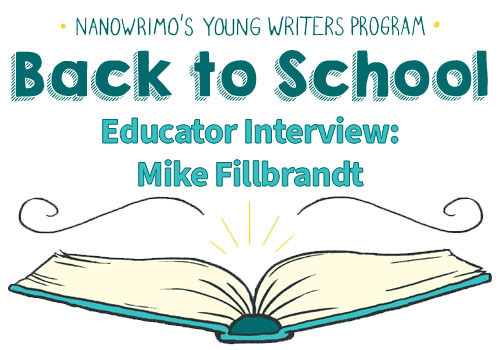
NaNoWriMo’s Young Writers Program helps over 85,000 kids, teens, teachers, and families set creative goals and tell stories they care about. We asked some of our amazing YWP educators to share how they take on the NaNoWriMo challenge in their classroom. Today’s advice comes from Mike Fillbrandt , who teaches 9th grade English at a charter school.
Q: What grade/ age level do you work with? What type of NaNoWriMo group is it (whole class, club, homeschool, elective, etc.)?A: 9th grade classes, 8-12 grade club
Q: How long have you been doing NaNoWriMo with your students?A: 5 years
Q: How do you structure the entire project (for example, do you start prepping in October and write in November, do you have kids work on it all year, etc.)?A: Prep in October (or March depending on the year), and write in November (or April).
Q: What does a normal NaNoWriMo day look like for your students?A: Brief self-check questionnaire, then the rest of the period to work. Some days are set aside for students to discuss their projects in small groups, to share successes, struggles, and get suggestions. Some days I hold one-on-one conferences with students to give feedback on excerpts of their projects and make suggestions for improving their writing.
Q: How do you set and manage word-count goals?A: Students need to complete 4500 words for full points. Students who exceed 10,000 can earn extra credit. For students with special needs, I coordinate with their case manager to determine an appropriate way to adjust word goal. Students who do not reach their word count goal receive a prorated portion of the word-count points.
Q: How do you manage grading? Do you grade?A: Yes, I grade. Grades are based on two required excerpts submitted for feedback, along with their final word count. The first excerpt, students can choose to be graded either on setting descriptions or on character building. For the second excerpt, students can choose to be graded either on plot development or on their use of dialogue. Each excerpt is worth 30 points (60 total), and the word count is worth 40 points, with a possibility of earning 50 by meeting the extra credit goal.
Q: How do you approach revision/ publishing (if at all)?A: In my most recent classes, I have only been able to give students post-writing suggestions/materials from the packet. In previous years, we were able to use an excerpt for practice with editing/revising skills.
Q: Any NaNoWriMo tips or tricks to share with other educators? Hard-won lessons? Ah-ha moments?A: Don’t try to read every word of every student story - you’ll drive yourself crazy. Instead, find a way to get a snapshot of a student’s work.
Begin the process of brainstorming ideas well in advance.
Be vigilant for signs of plagiarism and/or cheap tricks to pad out a word count without actually doing any work.
Q: Have you ever run into resistance from your administration about doing NaNoWriMo, and if so, how did you manage it? What do you say to people who don’t see the point of having students write novels?A: When I first began, there were concerns over word count goals, which I adjusted in later years.
Q: What are the most meaningful things you or your students take away from the project? What’s your best NaNoWriMo memory?A: Confidence, belief in their own abilities, a stronger sense of time management.
My best memory was the smile on a student’s face during an excerpt grading, when I told them how wonderful I thought their writing was.
Q: Anything else you’d like to add?A: I love this project. I’ve been doing NaNoWriMo longer than I’ve been a teacher.
Mike teaches 9th grade English at a charter school. He has participated in NaNoWriMo since 2005, and has had his students participate since he’s been teaching. He enjoys reading, writing, video games, disc golf, and attending a weekly writing group. He lives in Minnesota with his wife, daughter, one snake, two cats, along with an imaginary dog and an imaginary raccoon.
October 5, 2023
5 Essential Tips for Mastering Scene Writing in Your Novel

There’s many parts involved when writing a scene. Knowing how these different pieces work together may help you move forward in your novel. NaNo Participant Amy de la Force offers some tips on brushing up your scene writing knowledge.
Scenes are the building blocks of a novel, the stages where characters spring to life, conflicts brew and emotions run high. Mastering the art of scene writing is crucial for any aspiring writer, especially in the lead-up to NaNoWriMo. But what is a scene, and how do you effectively craft one?
A scene is a short period of time — in a set place — that moves the story forward with dramatic conflict that reveals character, generally through dialogue or action. Think of writing a scene as a mini-story with a beginning, middle and end, all contributing to the narrative.
Why Scene Writing is Your Secret Weapon in StorytellingWell-crafted scenes enhance your story to develop characters, advance the plot, and engage readers through tension and emotion. Whether you’re writing a novel, short story or even non-fiction, scenes weave the threads of your story together.
Tip #1: Scenes vs. SequelsAccording to university lecturer Dwight Swain in Techniques of the Selling Writer, narrative time can be broken down into not just scenes, but sequels.
Scene
The 3 parts of a scene are:
Goal: The protagonist or point-of-view (POV) character’s objective at the start of the scene.Conflict: For dramatic conflict, this is an equally strong combination of the character’s ‘want + obstacle’ to their goal. Disaster: When the obstacle wins, it forces the character’s hand to act, ratcheting up tension.Sequel
Similarly, Swain’s sequels have 3 parts:
Reaction: This is the POV character’s emotional follow-up to the previous scene’s disaster. Dilemma: If the dramatic conflict is strong enough, each possible next step seems worse than anything the character has faced. Decision: The scene’s goal may still apply, but the choice of action to meet it will be difficult. Tip #2: Questions to Ask Yourself Before Writing a SceneIn Story Genius, story coach and ex–literary agent Lisa Cron lists 4 questions to guide you in scene writing:
What does my POV character go into the scene believing?Why do they believe it?What is my character’s goal in the scene?What does my character expect will happen in this scene?Tip #3: Writing Opening and Closing ScenesNow that we know more about scene structure and character considerations, it’s time to open with a bang, or more to the point, a hook. Forget warming up and write a scene in the middle of the action or a conversation. Don’t forget to set the place and time with a vivid description or a little world-building. To end the scene, go for something that resolves the current tension, or a cliffhanger to make your scene or chapter ‘unputdownable’.
Tip #4: Mastering Tension and PacingA benefit to Swain’s scenes and sequels is that introspective sequels tend to balance the pace by slowing it, building tension. This pacing variation, which you can help by alternating dialogue with action or sentence lengths, offers readers the mental quiet space to rest and digest any action-packed scenes.
Tip #5: Scene Writing for Emotional ImpactFor writing a scene, the top tips from master editor Sol Stein in Stein on Writing are:
Fiction evokes emotion, so make a list of the emotion(s) you want readers to feel in your scenes and work to that list.For editing, cut scenes that don’t serve a purpose (ideally, several purposes), or make you feel bored. If you are, your reader is too. ConclusionFrom understanding the anatomy of a scene to writing your own, these tips will help elevate your scenes from good to unforgettable, so you can resonate with readers.

Amy de la Force is a YA and adult speculative fiction writer, alumna of Curtis Brown Creative’s selective novel-writing program and Society of Authors member. The novel she’s querying longlisted for Voyage YA’s Spring First Chapters Contest in 2021. An Aussie expat, Amy lives in London. Check her out on Twitter, Bluesky, and on her website! Her books can be found on Amazon.
Photo by cottonbro studio
October 4, 2023
How to Set Realistic NaNoWriMo Goals

Every year, we’re lucky to have great sponsors for our nonprofit events. Dabble , a 2023 NaNoWriMo sponsor , is a tool specifically designed for fiction novelists. Today, Dabbler Robert Smith shares a few tips to help you set daily writing goals that will work for you:
November looms, and with it the thrilling, harrowing, and sometimes carb-loaded journey of National Novel Writing Month. As we tie our writer’s capes and ready ourselves for a month of intense creation, there’s a small matter we need to address: our writing goals.
The Weight of 50,000 WordsSetting goals for NaNoWriMo is like setting a pace for a marathon. You wouldn’t expect to sprint a marathon. The same goes for writing. If you try to sprint through, chances are you’ll burn out faster than a candle in a windstorm.
However, only doing the minimum can leave you in a precarious position. Because if something comes up—and something always comes up—you’re suddenly behind on your goal, and that can really hurt morale.
So here are some goal setting tips to crush NaNoWriMo this year:
1. Start off strong, so you can end strong.There is a simple fact about motivation. It starts strong and wanes with time.
Now to be honest, you won’t be able to write a book with motivation alone. It requires a lot of discipline, and you’ll have to write even when you don’t feel like it.
But a great way to get the most out of that early motivation is to channel it into higher early output.
We all know that 50,000 words split over 30 days is 1667 words a day. But authors who win NaNoWriMo often don’t start there. They shoot for 2,500-3,000 words a day in the first week. That way they build up a buffer for the later weeks where motivation isn’t as high.
Plus, it gives them great forward momentum on their project. So consider setting higher goals early and taking advantage of your early NaNo fervor.
2. Account for daily life.Even if you’ve cleared your calendar for November, life has a knack for throwing curveballs.
Kids get sick. Work projects pop up. You know what I mean. If your word count goal is teetering on the edge of feasibility, any small disturbance can throw it off.
To combat this, make plans and backup plans. Schedule your writing time around family gatherings. Plan what happens if you miss a day. Set yourself up for success before those situations arise.
1. Use the buddy system.Find a writing buddy to be accountable to. It could be a friend participating in NaNoWriMo, or even someone you connect with in the NaNo community.
Check in with each other daily. Celebrate your wins, commiserate over the tricky bits, and hold each other accountable.
Sometimes, knowing someone else is in the trenches with you can be incredibly motivating.
3. Have weekly check-insInstead of focusing solely on daily targets, also have a weekly goal. This gives you a broader view and allows for some flexibility. If you have a slower day, you can make up for it later in the week without feeling like you’ve thrown the entire month off course.
4. Actually track your goals.Obviously, you need to track your goals, but there are multiple ways to do it.
Dabble integrates with NaNoWriMo, so you don’t have to manually submit your word count. And if you fall behind a bit, Dabble will automatically adjust your daily goal accordingly to keep you on track.
But even if you’re just marking off your goals on a napkin at your desk, tracking your progress will help you stay the course to victory.
Now go forth, share your stories, and remember: it’s not all about the word count; it’s about the words that count.
All NaNoWriMo participants can use the discount code NANOWRI2023 for 20% off 1 year of Dabble ! Offer expires January 31, 2024.
Robert Smith is a Dabbling Writer, and a Writing Dabbler. He likes playing board games with his wife, and deconstructing plots from movies in his spare time.
Top Photo by Isaac Smith on Unsplash .
October 3, 2023
Back to School: Interview with Ellice Gullet, Young Writers Program Educator
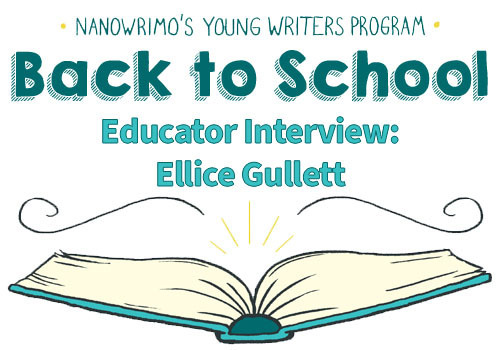
NaNoWriMo’s Young Writers Program helps over 85,000 kids, teens, teachers, and families set creative goals and tell stories they care about. We asked some of our amazing YWP educators to share how they take on the NaNoWriMo challenge in their classroom. Today’s advice comes from Ellice Gullet , who teaches special education, general education, and gifted and talented.
Q: What grade/ age level do you work with? What type of NaNoWriMo group is it (whole class, club, homeschool, elective, etc.)?A: I have worked with grades 2-7, whole group, and special education resource room.
Q: How long have you been doing NaNoWriMo with your students?A: I have been doing NaNoWriMo with my students for 8 years.
Q: How do you structure the entire project (for example, do you start prepping in October and write in November, do you have kids work on it all year, etc.)?A: September, we learn the parts of a story, using a basic story map. Then since they are elementary students, we read a couple of examples and put them on the mountain to practice recognizing the parts. In October, the students are given their own story map where they start to build their story. This takes all month and there is often revision as some of them will have a story with no real climax, or no real thread.
When they are done with these, we use them to write our stories in Nov. In November, we write in Google docs so we can use Google classroom, and they can use talk-to-text if they don’t have typing proficiency. We write in parts, and then in January we do self editing, two rounds of peer editing, then I do teacher edits. Then in March we have our stories put in an anthology and published for the students to purchase for home.
Q: What does a normal NaNoWriMo day look like for your students?A: We are fifth grade, so it usually includes 10-20 minutes of writing on school days, and no writing at home.
Q: How do you set and manage word-count goals?A: I have learned to set them low, or they ramble and don’t get a good story. Again, they are 5th graders, so their stories are 2-3 pages only.
Q: How do you manage grading? Do you grade?A: They get a grade for completing the project.
Q: How do you approach revision/ publishing (if at all)?A: In January, they read their story and fix anything they find glaring. As fifth graders, they don’t do a lot of grammar editing as much as plot changes. Then they have two student peers read their story and make comments. After they have finished that, I read them and make comments. Students fix the grammar and plot questions I have.
Q: What are the most meaningful things you or your students take away from the project? What’s your best NaNoWriMo memory?A: Parts of the story. Students who can identify a part of a story to write, can read and identify them which increases reading comprehension. Also several of my students have decided that they are in fact Authors, that when they grow up they want to be a writer. So that is amazing. Also some of the creative imagery these students come up with is amazing.
Q: Anything else you’d like to add?A: Set guidelines on what they can’t write about, like suicide, violence at school, violence against a student, but give them as much freedom to write as you can. Some like to write horror and let that be okay. Also prewarn your monitor for your school computer system, so they don’t pull kids with concerns because of their content!
Ellice Gullett is a highly qualified teacher of special education, general education and gifted and talented. She has been teaching for 23 years. Writing is a large portion of her class. She is also an aspiring author herself.
September 28, 2023
Back to School: Interview with Teresa Lyons, Young Writers Program Educator
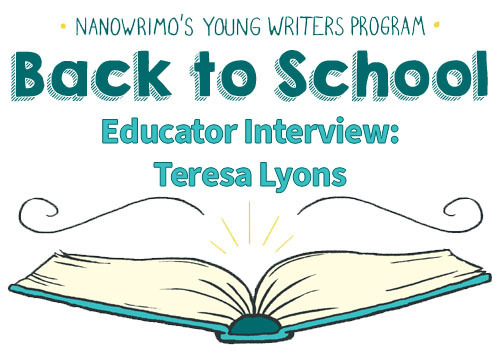
NaNoWriMo’s Young Writers Program helps over 85,000 kids, teens, teachers, and families set creative goals and tell stories they care about. We asked some of our amazing YWP educators to share how they take on the NaNoWriMo challenge in their classroom. Today’s advice comes from Teresa Lyons , a long-time writer and teacher going on her 23rd year.
Q: What grade/ age level do you work with? What type of NaNoWriMo group is it (whole class, club, homeschool, elective, etc.)?A: High school creative writing, 9-12 graders, whole class, semester long elective. Previously, I used it with my 7th & 8th graders, whole class, during our narrative unit.
Q: How long have you been doing NaNoWriMo with your students?A: 5+ years
Q: How do you structure the entire project (for example, do you start prepping in October and write in November, do you have kids work on it all year, etc.)?A: We begin quick writes in September as we go over story elements. Then we take those and select several to blow up to completed short stories. In mid-October, we begin prepping for NaNoWriMo using elements from the provided pre-writing book and writer’s workshop. We create our novellas in November and then do edits and turn in a sample of the work, called a NaNoWriMo First Look, in December. If I had the kids all year, I would wait and do the edits in January but I don’t have that option.
Q: What does a normal NaNoWriMo day look like for your students?A: During November, we write a full class period four days a week. On Fridays, we have writers’ groups for 20-25 minutes, where students can talk about their stories, share excerpts, discuss any issues they are having, etc. Then when writers’ groups are over, they have the rest of the period (about 30 minutes) to apply any feedback they got in their writers’ groups and to continue working on their stories.
Q: How do you set and manage word-count goals?A: Students are allowed to choose their own word count as long as it meets or is above the class minimum. The minimum is 5,000-8,000 words, depending on the class. I also participate in NaNoWriMo and set a higher goal, typically 10,000-15,000 words depending on what their minimum is. If they beat my goal, they get a little prize and bragging rights for outwriting me.
Q: How do you manage grading? Do you grade?A: My students get two grades for NaNoWriMo. One is a grade for the word count. They get whatever their percentage is as their word count grade. This goes in the classwork grading category of my grade book (which is a small category to begin with). The other grade they get is for their NaNoWriMo First Look. For this assignment, they turn in revised and edited excerpts of their novel for me to grade. They create a book cover, a synopsis of the novel, and then hand in their best examples of indirect characterization, the main conflict, meaningful dialogue, the climax, and their favorite scene.
Q: How do you approach revision/ publishing (if at all)?A: Since my class is only a semester long, we begin revisions a few days into December. They revise and edit specifically to create their NaNoWriMo First Look assignment. I have always wanted to publish their writings in a book but the timing doesn’t work out. If there was someplace we could just submit the PDFs when they are done with them, then I might be able to pull off getting it published.
Q: Any NaNoWriMo tips or tricks to share with other educators? Hard-won lessons? Ah-ha moments?A: Be super excited and start talking it up early. I introduce it the first week of school and the students can tell I am pumped up about it. I refer to it often and I call it their “Great American Novella”. My excitement helps them be more excited about it.
I assure my students who might be anxious about it that they will have several weeks in October to prep and plan out their story. I tell them that they will have characters planned, the basic plot line mapped out, and so on. I also do story starter quick writes with my students and a lot of them use one of those as a bouncing off point for their novella.
The fact that I write with the kids really motivates them because I am not asking them to do something that I can’t or won’t do. Also, some just really want to outwrite me. I always give the ones who do a little wooden ornament that says NaNoWriMo and the year on one side and I outwrote Mrs. Lyons on the other side.
When I did this with my 7-8th graders, I would do two Write Ins, one at the beginning and one at the end of November. I would take over a big room after school and they could come and write for a few hours. I ordered pizza and sodas. They loved it. Even if they weren’t always writing, they were talking about their stories and bouncing ideas off of each other (even if they didn’t realize it). Those who wanted to focus brought in headphones and listened to music while they wrote.
I let my students listen to their own music while they write. What works for me when writing may not work for them and visa versa. They really appreciate being able to do this.
Q: Have you ever run into resistance from your administration about doing NaNoWriMo, and if so, how did you manage it? What do you say to people who don’t see the point of having students write novels?A: I have been fortunate that my admin has always been at least somewhat supportive. When I did this with my middle schoolers (7-8th graders), it was part of a regular ELA class. I timed my narrative unit to be October and November. I would give them one class day a week to write and then their only homework from me was working on their NaNoWriMo. I never had any pushback or complaints.
Q: What are the most meaningful things you or your students take away from the project? What’s your best NaNoWriMo memory?A: The most meaningful thing that they take away is the sense of accomplishment at doing it, meeting their word goal. No other writing assignment seems overwhelming when you have written a 7,000ish word novella. The kids who think there is no way that they can do this and then do, the confidence it gives them lasts for years. I have had previous 7-8th graders reach out to me when they are in high school to let me know that while their classmates might be panicking over a three page paper, they are stressed a bit because they know they can write that because they have and so much more.
My favorite memory of NaNoWriMo has to be the Write Ins I did when I was at the middle school. All those kids coming together, on their own time, sharing their stories and ideas and just so excited about what they were doing. It was great.
Mrs. Lyons is a teacher going on her 23rd year, but she has been a writer much longer than that. She currently teaches high school, senior English and creative writing, but most of her career has been spent at the middle school level teaching 6-8th grade ELA. She is excited to bring NaNoWriMo to her students every year and to be given the chance to write as well. Mrs. Lyons has been working on a book during NaNoWriMo that she needs to finish soon because her youngest daughter wants to know what happens to all of the characters.
Chris Baty's Blog
- Chris Baty's profile
- 63 followers



